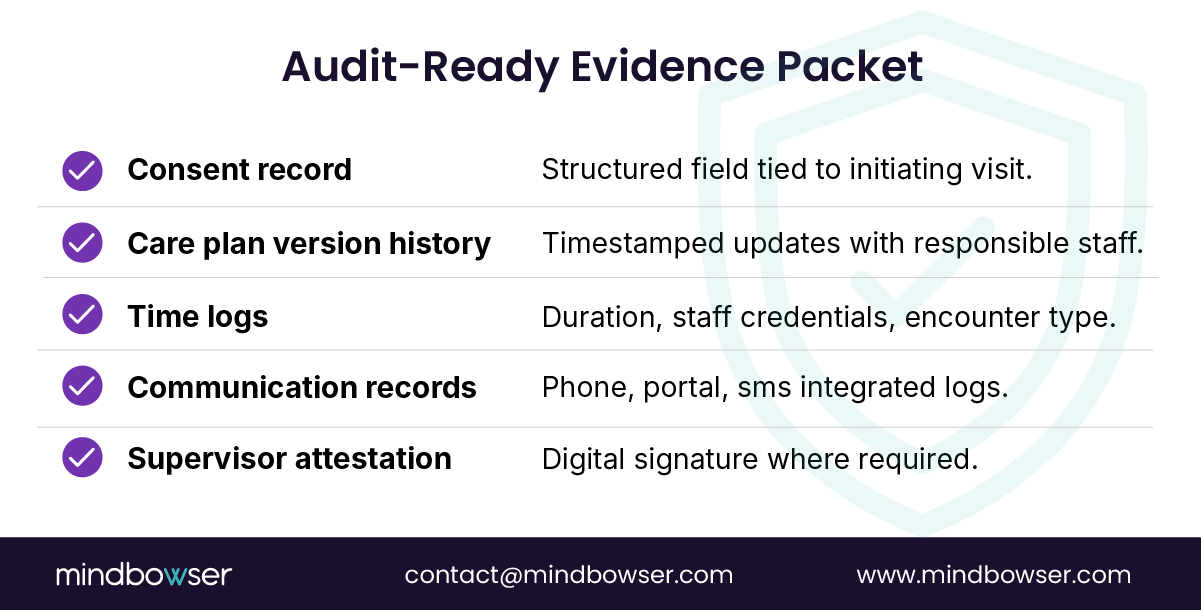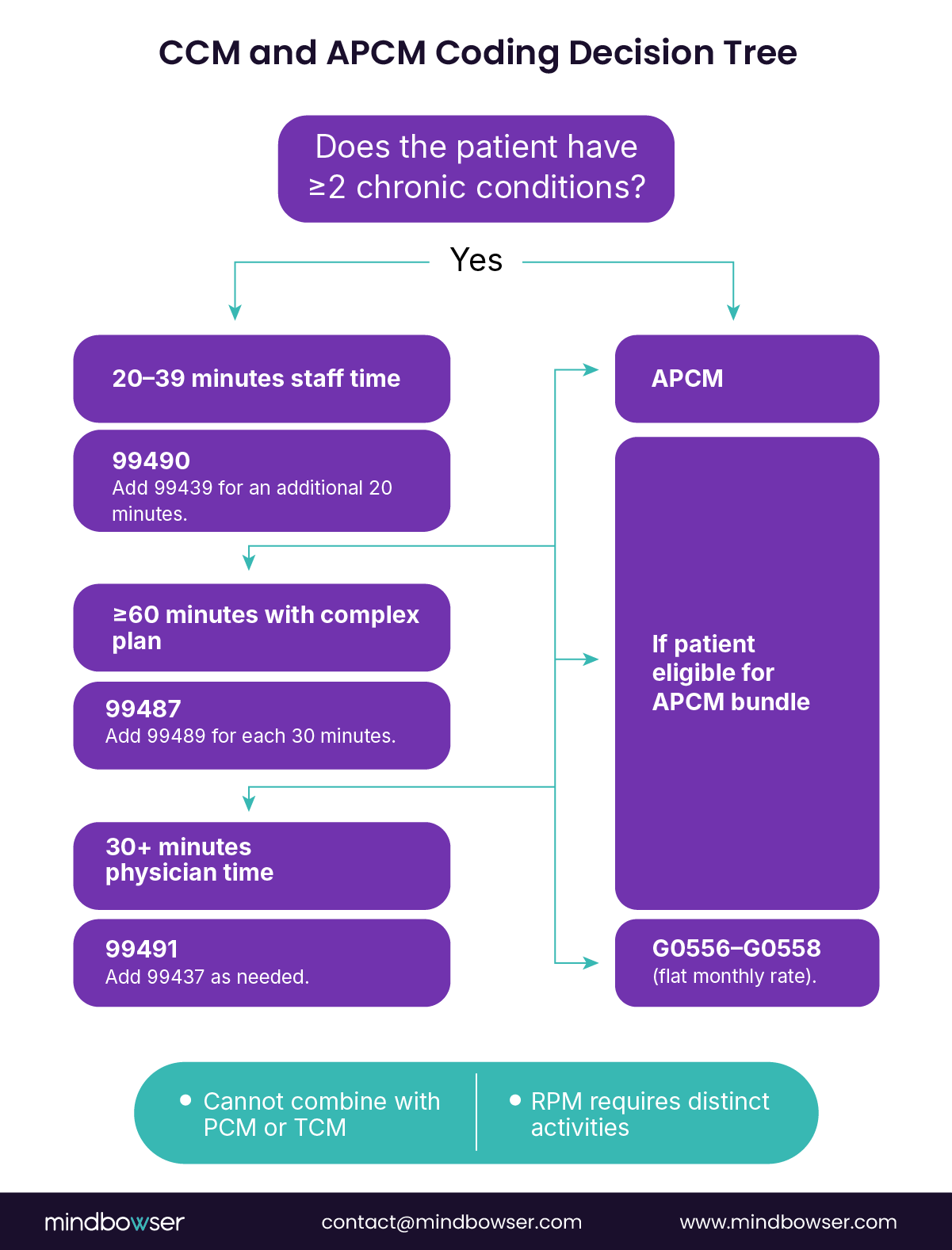Chronic Care Management (CCM) CPT codes remain one of the most underutilized levers for health systems and digital health companies in 2025. Used correctly, they can generate recurring revenue, improve quality scores, and reduce the risk of readmission. The challenges include coding complexity, new rules around APCM (G0556–G0558), and increased audit scrutiny. This guide explains:
I still remember when we first built a CCM program for a 200-bed hospital. The coding grid looked straightforward on paper—99490 for 20 minutes, 99439 for add-ons, 99491 for physician time. However, the moment we scaled across three clinics, the cracks began to appear: missed minutes, concurrency denials, and staff who spent more time justifying their time logs than talking to patients.
Fast forward to 2025. The rules have evolved, APCM codes now sit alongside CCM, and rural clinics face new realities with the retirement of G0511. Yet the fundamentals have not changed. CCM is not just about billing minutes; it is about structuring workflows, data, and audit trails so that every encounter both improves patient care and withstands CMS review.
This blog is written for CTOs, CIOs, CMIOs, and CFOs who are responsible for building the digital backbone of these programs. My perspective is that of an engineer and product lead—we have integrated CCM modules into EHRs, mapped care plans into FHIR, and built ROI models that convince finance teams. The goal here is to provide you with a playbook: not just which codes to use, but also how to operationalize them with technology and governance.
Related read: CCM Codes / CPT Variants: The 2025 Comparison Guide for CTOs and CFOs
When CMS introduced the Advanced Primary Care Management (APCM) codes—G0556, G0557, and G0558—it signalled a pivot. Instead of billing every 20 or 30 minutes of staff or physician time, APCM pays a monthly bundled rate for eligible patients. This matters because it removes the operational grind of minute counting. For CTOs, the challenge shifts from building time-tracking logic to building a data-first infrastructure that can show monthly care continuity, quality outcomes, and engagement frequency.
Bottom line: APCM rewards longitudinal coordination, not stopwatch accounting. Health systems that adopt APCM can simplify billing, but they must demonstrate consistency through effective data integration and reporting.
For Federally Qualified Health Centers and Rural Health Clinics, 2025 brought the retirement of G0511. That single consolidated code is gone, forcing clinics to bill under CCM, RPM, or APCM instead. On the ground, this means retraining coders, remapping EHR templates, and ensuring staff know which patients qualify under which pathway. I’ve seen rural CIOs underestimate this shift, only to face denials when old codes still sit in their billing systems.
The operational burden is real. However, for leaders who move quickly, there is an upside: by adopting APCM early, these organizations can strengthen financial predictability while aligning with CMS’s broader shift to value-based reimbursement.
The third major update provides clearer guidance on how Remote Patient Monitoring (RPM) and Principal Care Management (PCM) can coexist with CCM. RPM treatment management codes (99457/99458) can complement CCM, but only when documentation distinctly separates device data review from care plan activities. PCM remains mutually exclusive with CCM for the same patient and month, but APCM has carved out some nuanced exceptions.
For a CTO, this interplay is a systems problem. Your EHR must segment encounters, timestamps, and care plans in a manner that prevents double-billing. That requires FHIR-based data partitioning and concurrency logic embedded at the workflow level. The technology investment here pays off by reducing denials and audit exposure.
The first question every CTO or CMIO asks me when we scope a CCM program is: Who qualifies? CMS requires patients to have two or more chronic conditions expected to last at least 12 months or until death. These conditions must pose a significant risk of death, acute decompensation, or functional decline. In practical terms, this means patients with hypertension, diabetes, COPD, CHF, or CKD form the bulk of eligible panels.
Here’s the catch. Eligibility is often lost in fragmented records. A hospital may flag a patient for hypertension in one system but miss the comorbidity logged during a specialist visit. Without integration, you undercount eligible patients and leave revenue on the table. In one project, we raised the eligible panel size by 22% simply by unifying diagnosis codes across inpatient and ambulatory feeds.
Bottom line: Eligibility is not a static label; it is a data aggregation problem. If your systems don’t harmonize ICD-10 codes and problem lists, you will miss patients that CMS would reimburse for.
CMS is clear: for new CCM enrollment, patients must have an initiating visit, which can be an annual wellness visit, an evaluation and management visit, or a transitional care management encounter. This ensures the patient understands the service and consents to ongoing management. Consent can be verbal or written, but it must be documented and auditable.
This is where programs stumble. I have seen consent forms buried in scanned PDFs or verbal agreements logged in free-text notes that fail audits. The fix is simple but technical: build structured consent capture into your EHR workflow, linked to the patient record, with time stamps and staff attribution. When auditors ask, you should be able to pull a clean log in under two minutes. Anything slower risks penalties.
Consent is also a moment of trust. If enrollment feels rushed, patients disengage. Our teams design scripts for RNs that frame CCM as a benefit, not a bill. When done right, consent becomes the start of engagement, not just a compliance checkbox.
Enrollment is where technology, staffing, and patient experience converge. The most successful programs treat enrollment like a funnel: identify eligible patients, educate them, secure consent, and document initiation.
When we piloted a CCM enrollment module at a regional hospital, the initial completion rate was 38%. By adding structured EHR prompts and a consent dashboard, we increased the rate to 62% in three months. That shift alone created an additional $480K in projected annual reimbursement.
For CTOs and CFOs, this is where ROI begins. Eligibility defines the top of the funnel, consent secures compliance, and enrollment efficiency dictates scale. Without a tight workflow, you leave both patients and dollars unserved.
Related read: CCM Audit Risk & Protection: A Compliance Playbook for 2025

Every CCM service hinges on the care plan. CMS expects it to be comprehensive, dynamic, and patient-centered. At a minimum, it must include:
Here is where technology plays defense. Too many EHRs treat care plans as static documents. Our engineering teams instead build care plans as FHIR CarePlan resources with structured fields that can be versioned, updated, and queried. That design ensures every change is traceable, which is critical when auditors demand evidence of “ongoing revision.”
Bottom line: A care plan that resembles a PDF will not be accepted. A care plan that behaves like structured data will.
One of the top drivers of denials in CCM is concurrent care management. CMS prohibits billing CCM in the same month as Transitional Care Management (TCM), Principal Care Management (PCM), and some behavioral health codes for the same patient. You can bill CCM with RPM, but only if the activities are distinct and time is not double-counted.
The problem is not the rules themselves, but the execution. Staff often log 15 minutes of blood pressure coaching under both RPM and CCM, which triggers audit flags. The solution is to embed concurrency logic directly in the workflow:
I have seen health systems lose six figures annually from concurrency denials. Once we implemented real-time concurrency checks in the EHR middleware, denials dropped by 70%.
Auditors do not want promises; they want proof. CMS requires that every billed unit of CCM be backed by verifiable documentation. Strong programs generate an evidence packet that includes:
The fastest way to fail an audit is to scramble for artifacts across multiple systems. That is why we build AuditEvent resources in FHIR that capture every transaction. With this approach, when CMS or a payer requests records, the export is one click.
One of our clients underwent a targeted probe audit in 2024. Because their artifacts were centralized and structured, the audit closed in six weeks with no recoupment. Compare that to peers who spend months compiling spreadsheets and PDFs.
Bottom line: If your program cannot produce a clean evidence packet on demand, you are not audit-ready. And if you are not audit-ready, your margins are at risk.
Medicare’s 2025 Physician Fee Schedule sets national reimbursement at roughly $60 for CPT 99490 (the first 20 minutes of clinical staff time). Add-on codes, such as 99439, generate approximately $47 for each additional 20 minutes. Complex CCM codes—99487 and 99489—pay higher, with a base reimbursement of nearly $95 and add-ons at $47 for each 30 minutes. Physician time codes 99491 and 99437 cost approximately $80–$ 85 per 30 minutes.
These are national averages. Local adjustments matter. Urban markets with higher wage indices can expect 5–15% higher reimbursement, while rural markets may experience a trend of lower reimbursement. Commercial payers also layer on their own variations. Some match CMS, others pay less, and a few bundle CCM into broader population health programs.
Bottom line: If you model revenue only on the CMS national average, you risk overestimating in some markets and underestimating in others. The CFO requires locality-specific fee schedules, and the CTO must ensure that billing systems incorporate payer-specific contracts into their calculators.
Revenue is one side of the equation, staffing is the other. A typical RN costs $38–42 per hour fully loaded, while an LPN averages $28–32, and a medical assistant may run $20–25. Since CCM codes reimburse based on staff time under physician supervision, the staffing mix defines margin.
Take a clinic with 500 eligible patients:
Now apply staffing costs. At 20 minutes per patient, that’s 5,000 minutes, or ~83 hours of staff time. If staffed with RNs at $40 per hour, labor cost is $3,320. Net margin: ~$11,680 before overhead.
Shift the mix to LPNs supervised by an RN, and costs drop closer to $2,400 for the same workload, lifting net margin by $900 per month. Multiply that across a year, and you see why staffing optimization is not optional; it is the program’s profit lever.
Related read: How Much Does Medicare Pay for Chronic Care Management in 2025
Every CCM program lives or dies by the care plan. CMS expects it to be a living document that reflects patient goals, medications, and interventions. In practice, most EHRs treat it as static text, which breaks down once audits start.
The modern approach is to model care plans as FHIR CarePlan resources. That means structured data elements, not just narrative notes. Each problem, goal, and intervention is a discrete object. Each update is tracked through Provenance resources that capture who made the change and when. For operational clarity, tasks such as “review blood pressure readings” or “schedule follow-up” can be logged as FHIR Task resources, each with a status and timestamp.
When we developed this pattern for a multi-site hospital, it completely changed audit preparation. Instead of scrambling through PDFs, their compliance team could export a JSON log of every care plan update in under a minute. That single improvement reduced audit prep from weeks to hours.
CCM is not only about time. It is about data that proves continuity of care. To align with national standards, the care plan must map to USCDI v4 data classes. At a minimum, that includes:
The key is consistency. If your EHR records vitals in free text or if SDOH data is stored in an unstructured note, it will never be included in payer reporting or HEDIS measures. A clean USCDI mapping ensures every CCM encounter not only passes billing audits but also lifts performance on quality contracts.
For CTOs, the toughest challenge is not coding, it is plumbing. CCM workflows often span multiple systems, including EHRs, call center software, patient apps, and sometimes external RPM platforms. If each operates in a silo, data gaps will undercut both reimbursement and compliance.
The architecture that works is event-driven. Every CCM interaction generates an AuditEvent in FHIR, regardless of whether it involves a phone call, a secure message, or a review of device data. These events flow through an integration bus, tagged to the patient record, and roll up into monthly reports. Supervisors see progress in real time. Compliance officers get an exportable audit packet. Finance teams see revenue forecasts tied directly to the completion of tasks.
We implemented this at a health system where CCM, RPM, and behavioral health programs overlapped. By wiring all activity into FHIR subscriptions, we gave leaders a unified view of minutes logged, tasks completed, and patients touched. Denials dropped 30% in the first quarter.
Bottom line: CCM is a data integration problem disguised as a billing code problem. If you model care plans and encounters as structured FHIR and USCDI objects, you future-proof your program. If you do not, you invite denials, audit risk, and missed revenue.
CMS audits are getting tougher—but your team doesn’t have to struggle. Learn how to structure FHIR-based care plans, automate consent, and generate instant audit packets.
Care management is not only a revenue stream, but it is also a performance driver in contracts. CMS and commercial payers tie significant dollars to HEDIS and Star measures. CCM programs directly affect several of them.
In one deployment, incorporating structured blood pressure monitoring into CCM increased CBP control rates from 61% to 74% within six months. That alone lifted quality bonuses by $400,000 under the hospital’s payer contract.
Bottom line: Every CCM encounter is not just minutes; it is quality data that feeds contract metrics.
Population health leaders need more than anecdotes. They need registries and dashboards that show how CCM lifts outcomes across cohorts. With structured FHIR and USCDI data, it becomes possible to build registries segmented by condition, risk score, or payer contract.
These registries answer critical questions:
At one regional ACO, we integrated CCM and RPM data streams into a central dashboard. The CFO could see, in real time, how CCM enrollment correlated with reduced admissions in CHF patients. That visibility was a turning point in contract negotiations with payers.
CCM also plays into the broader shift toward value-based contracts. Shared savings programs and risk corridors hinge on measurable improvements in chronic care. Without CCM infrastructure, providers struggle to demonstrate continuity of care at scale.
Here is the strategy we have seen work:
When one of our digital health clients layered CCM data into their negotiations, they secured a contract addendum that paid an additional $100 per patient per month for improved hypertension control. That margin shift was only possible because they could prove impact with structured, auditable data.
Bottom line: CCM is not just about capturing today’s reimbursement. It is about building the evidence base that unlocks tomorrow’s value-based contracts. Quality outcomes and payer negotiations are won or lost in the way you operationalize CCM data.

The first fork in the decision tree is deciding whether the patient qualifies for standard CCM, complex CCM, or physician/QHP time codes.
From a systems standpoint, the EHR should prompt staff or providers with a structured workflow: “Did the patient meet complexity criteria? Was physician/QHP time personally logged? If not, default to staff CCM codes.” Embedding this logic reduces miscoding and denials.
The 2025 addition of Advanced Primary Care Management (APCM) codes—G0556, G0557, G0558—introduced new strategic choices. APCM pays a flat monthly rate for eligible patients without minute tracking.
In practice, health systems often stratify patients: higher-risk, time-intensive patients stay under CCM for add-on revenue, while stable chronic patients shift to APCM for predictability. A decision matrix in your EHR can automate this process by considering care intensity and payer eligibility.
The most common coding mistakes come when combining CCM with Remote Patient Monitoring (RPM) or Principal Care Management (PCM).
Here is how we solve this operationally: we build concurrency logic into middleware that sits between the EHR and billing system. If a patient is enrolled in PCM, CCM codes are suppressed automatically. If staff attempt to log time under both CCM and RPM for the same interaction, the system forces them to categorize it accordingly. That approach reduced concurrency denials by 70% in one client deployment.
Bottom line: Coding clarity is not just about knowing the rules; it’s also about applying them effectively. It is about hard-wiring those rules into workflows, so clinicians focus on care and the system protects revenue.
One of the first decisions leaders face is whether to build a centralized CCM team or embed care managers within each clinic.
In practice, many systems adopt a hybrid model, centralizing the majority of outreach and monitoring while embedding high-touch staff for complex patients or specialty clinics. When we piloted this model at a 300-bed hospital, throughput increased by 25%, and provider satisfaction rose because local clinics still felt supported.
Bottom line: Efficiency resides in centralization, while trust resides in embedding. The right model depends on panel size, geography, and culture.
CCM documentation and coding are unforgiving. A single vague note, such as “spoke with patient about meds,” can sink a claim. That is why structured training and quality assurance are non-negotiable.
Training should cover:
Quality assurance is equally critical. The best programs run monthly documentation audits. Supervisors review a random sample of encounters, checking for missing time stamps, incomplete care plan updates, or concurrency violations. When issues are found, staff are retrained within the same cycle.
We built a QA dashboard for one client that flagged incomplete notes in real time. The result: denial rates dropped from 12% to under 5% in three months.
Denials are the silent killer of CCM margins. They are often not discovered until months later, at which point revenue recovery is slow or impossible to achieve. The most effective programs build denial prevention into the workflow.
Key tactics include:
In one deployment, these steps reduced denials from 14% to 4% in under a quarter. For a hospital with 1,000 enrolled CCM patients, this meant nearly $250,000 in annual revenue protection.
Bottom line: Staffing models, training, and denial prevention are not back-office details. They are the difference between a CCM program that bleeds margin and one that generates reliable recurring revenue.
See how leading hospitals cut denials by 70%, lifted margins by $50 per patient, and boosted quality scores—all within 90 days.
Every CCM program sits on top of three core layers:
In one deployment, we built a middleware layer between Epic and a third-party CCM platform. That layer automatically pushed care plan updates back into Epic while logging outreach minutes from the call system. The compliance team called it their “safety net” because nothing slipped through the cracks.
Human error is the enemy of reimbursement. The solution is automation. Every CCM program should include:
Reliability also matters. If a platform goes down for even a day, staff either miss encounters or log them manually, both of which create audit risk. High uptime, redundant logging, and strong SLAs are not nice-to-haves. They are essential.
The final piece is how you report and defend your program. Auditors want evidence, not effort. The most effective CCM stacks produce audit packets on demand that include:
To achieve this, we design systems that use FHIR AuditEvent and Provenance resources. Every transaction—whether a note, a call, or a consent capture—is tagged with the details of who did it, when, and under what context. When auditors arrive, exporting the packet is as easy as one click, not a two-week scramble.
One of our hospital partners went through a CMS probe audit in 2024. Because their architecture used audit-ready FHIR logs, they passed without recoupment. Their compliance officer told me, “For once, I slept during an audit.” That is the ROI of building controls into your architecture.
Bottom line: Technology architecture is not about shiny tools. It is about building a resilient, auditable, and integrated stack that protects revenue while making life easier for staff. If you cannot generate a complete audit packet instantly, you are gambling with your margins.
A large health system struggled with rising costs for oncology patients and poor medication adherence. By integrating CCM codes into financial navigation workflows, they began tracking medication refills and care plan adjustments in real time. The CCM revenue offset the staffing cost, while patients gained consistent outreach. Within six months, 30% more oncology patients remained adherent to their therapy, and the hospital recaptured $1.2 million in payer reimbursements that would have been lost without proper documentation.
A regional network faced high readmission rates among patients with CHF, diabetes, and COPD. They deployed a complex CCM program using 99487 and 99489 to cover longer, high-touch care management. Through structured care plans, RN supervision, and embedded LPN outreach, the network achieved an 18% reduction in readmissions year-over-year. The CCM program itself generated $2.8 million in net new reimbursement, but the real win was in contract performance: their value-based payer contract bonus doubled because readmission penalties decreased.
A community hospital found that many CCM patients also faced challenges with housing, food, and transportation. By embedding SDOH screening into CCM care plans and mapping data to USCDI classes, they documented needs, generated referrals, and tracked follow-through. Within a year, 41% of identified social needs were addressed, and the rate of uncontrolled hypertension dropped by 12%. The payer rewarded the hospital with a contract extension and a $500 annual incentive per patient for demonstrated SDOH management.
A Series B digital health company delivering virtual primary care used CCM codes to stabilize revenue between venture rounds. By automating consent capture and enrollment workflows, they raised CCM enrollment from 20% to 55% of eligible patients. This generated a predictable $4.5 million annual revenue stream. More importantly, patients who enrolled in CCM renewed their digital health memberships at twice the rate of those who did not, directly improving lifetime value.
Related read: Building a Chronic Care Management Program: A 2025 Playbook for Hospitals and Digital Health Leaders
Every CTO, CIO, or CFO evaluating a CCM program eventually asks the same question: What should we require before we invest? Below is a practical checklist drawn from successful implementations.
Related read: CCM Billing 2025: Codes, APCM & ROI
The Concern: Many organizations piloted CCM years ago and found the revenue did not justify the administrative burden.
The Answer: The 2025 environment is different. APCM codes now simplify billing by eliminating minute tracking for certain cohorts. Technology has matured to automate time logging, consent capture, and concurrency rules. Denials that once ate into margins can now be prevented upstream. In one hospital where denials were running at 12%, adding real-time concurrency checks and audit-ready templates lifted net revenue by 18% in a single quarter.
Bottom line: CCM does pay—when engineered with automation and staffing models that protect margin.
The Concern: CFOs and compliance officers fear retroactive audits that claw back months of revenue.
The Answer: Audit risk is real, but it can be mitigated with the right architecture. Structured consent, versioned care plans, and FHIR AuditEvent logs mean that every billed unit of CCM has a digital footprint. When one of our partners faced a CMS probe audit, they closed it in six weeks with no repayment because every care plan and time log was exportable in seconds.
Bottom line: Audit risk is not eliminated, but with proper controls, it shifts from a liability to a defensible strength.
The Concern: Leaders often believe their EHR cannot support CCM workflows without extensive customization.
The Answer: Many EHR modules for CCM are indeed clunky. That is why middleware and integration layers exist. A well-designed middleware can automate time capture, synchronize care plan updates, and enforce concurrency rules while feeding structured data back into the EHR of record. This approach has allowed hospitals running Epic, Cerner, and athenahealth to scale CCM without waiting years for native modules to mature.
Bottom line: CCM is not limited by the EHR; it is enabled by how you integrate around it.
Mindbowser has built accelerators that address the exact pain points CCM programs struggle with:
These accelerators automate manual work, reduce denials, and expedite revenue cycles.
Our approach is not theoretical. We run six-week pilots with defined KPIs: enrollment rates, average minutes captured, denial rates, and projected revenue. We integrate with leading EHRs, configure middleware for concurrency checks, and hand off a complete audit kit to compliance teams.
In a recent pilot, enrollment increased from 35% to 58% within six weeks, denial rates dropped by half, and the CFO had a clear ROI model for scaling across the system.
Clients do not just get software—they get measurable results. With Mindbowser’s accelerators:
Related read: Chronic Care Management Software: Building Compliance-Ready, ROI-Driven Platforms for 2025 and Beyond

The path forward is not abstract. There are three immediate steps every CTO, CIO, CMIO, or CFO can take:
Leadership teams must track more than revenue. The right KPIs include:
When measured consistently, these KPIs create a continuous improvement cycle that strengthens both financial performance and patient outcomes.
Yes, but activities must be distinct from each other. Reviewing RPM device data is billed under 99457 or 99458, while updating care plans or coordinating with specialists counts under 99490 or 99439. The system must clearly separate minutes to avoid double-counting. Programs that fail here are the ones most likely to face denials.
Complex CCM (99487 and 99489) applies when the patient requires 60 minutes or more of clinical staff time and the care plan involves moderate to high medical decision-making. Standard CCM (99490 and 99439) applies when staff spend at least 20 minutes on less complex patients. In audits, reviewers look for narrative evidence of complexity, such as frequent medication adjustments or the involvement of multiple specialists.
APCM (G0556–G0558) pays a flat monthly rate for eligible patients and does not require minute tracking. CCM remains time-based. Organizations often stratify patients: higher-touch patients stay under CCM, while stable cohorts shift to APCM. Both cannot be billed for the same patient in the same month. The decision should be driven by expected care intensity and payer mix.
Auditors expect a complete evidence packet that includes:
Without this packet, claims are at risk of denial or repayment.
ROI depends on four levers: enrollment rate, minutes per patient, denial rate, and staffing costs. A base case typically yields a net margin of $35–60 per patient per month. A sensitivity model should show low, base, and high scenarios. CFOs should test the model with local fee schedules and staffing assumptions. Programs that track ROI monthly catch issues before they erode margins.

We worked with Mindbowser on a design sprint, and their team did an awesome job. They really helped us shape the look and feel of our web app and gave us a clean, thoughtful design that our build team could...


The team at Mindbowser was highly professional, patient, and collaborative throughout our engagement. They struck the right balance between offering guidance and taking direction, which made the development process smooth. Although our project wasn’t related to healthcare, we clearly benefited...

Founder, Texas Ranch Security

Mindbowser played a crucial role in helping us bring everything together into a unified, cohesive product. Their commitment to industry-standard coding practices made an enormous difference, allowing developers to seamlessly transition in and out of the project without any confusion....

CEO, MarketsAI

I'm thrilled to be partnering with Mindbowser on our journey with TravelRite. The collaboration has been exceptional, and I’m truly grateful for the dedication and expertise the team has brought to the development process. Their commitment to our mission is...

Founder & CEO, TravelRite

The Mindbowser team's professionalism consistently impressed me. Their commitment to quality shone through in every aspect of the project. They truly went the extra mile, ensuring they understood our needs perfectly and were always willing to invest the time to...

CTO, New Day Therapeutics

I collaborated with Mindbowser for several years on a complex SaaS platform project. They took over a partially completed project and successfully transformed it into a fully functional and robust platform. Throughout the entire process, the quality of their work...

President, E.B. Carlson

Mindbowser and team are professional, talented and very responsive. They got us through a challenging situation with our IOT product successfully. They will be our go to dev team going forward.

Founder, Cascada

Amazing team to work with. Very responsive and very skilled in both front and backend engineering. Looking forward to our next project together.

Co-Founder, Emerge

The team is great to work with. Very professional, on task, and efficient.

Founder, PeriopMD

I can not express enough how pleased we are with the whole team. From the first call and meeting, they took our vision and ran with it. Communication was easy and everyone was flexible to our schedule. I’m excited to...

Founder, Seeke

We had very close go live timeline and Mindbowser team got us live a month before.

CEO, BuyNow WorldWide

Mindbowser brought in a team of skilled developers who were easy to work with and deeply committed to the project. If you're looking for reliable, high-quality development support, I’d absolutely recommend them.

Founder, Teach Reach

Mindbowser built both iOS and Android apps for Mindworks, that have stood the test of time. 5 years later they still function quite beautifully. Their team always met their objectives and I'm very happy with the end result. Thank you!

Founder, Mindworks

Mindbowser has delivered a much better quality product than our previous tech vendors. Our product is stable and passed Well Architected Framework Review from AWS.

CEO, PurpleAnt

I am happy to share that we got USD 10k in cloud credits courtesy of our friends at Mindbowser. Thank you Pravin and Ayush, this means a lot to us.

CTO, Shortlist

Mindbowser is one of the reasons that our app is successful. These guys have been a great team.

Founder & CEO, MangoMirror

Kudos for all your hard work and diligence on the Telehealth platform project. You made it possible.

CEO, ThriveHealth

Mindbowser helped us build an awesome iOS app to bring balance to people’s lives.

CEO, SMILINGMIND

They were a very responsive team! Extremely easy to communicate and work with!

Founder & CEO, TotTech

We’ve had very little-to-no hiccups at all—it’s been a really pleasurable experience.

Co-Founder, TEAM8s

Mindbowser was very helpful with explaining the development process and started quickly on the project.

Executive Director of Product Development, Innovation Lab

The greatest benefit we got from Mindbowser is the expertise. Their team has developed apps in all different industries with all types of social proofs.

Co-Founder, Vesica

Mindbowser is professional, efficient and thorough.

Consultant, XPRIZE

Very committed, they create beautiful apps and are very benevolent. They have brilliant Ideas.

Founder, S.T.A.R.S of Wellness

Mindbowser was great; they listened to us a lot and helped us hone in on the actual idea of the app. They had put together fantastic wireframes for us.

Co-Founder, Flat Earth

Mindbowser was incredibly responsive and understood exactly what I needed. They matched me with the perfect team member who not only grasped my vision but executed it flawlessly. The entire experience felt collaborative, efficient, and truly aligned with my goals.

Founder, Child Life On Call

The team from Mindbowser stayed on task, asked the right questions, and completed the required tasks in a timely fashion! Strong work team!

CEO, SDOH2Health LLC

Mindbowser was easy to work with and hit the ground running, immediately feeling like part of our team.

CEO, Stealth Startup

Mindbowser was an excellent partner in developing my fitness app. They were patient, attentive, & understood my business needs. The end product exceeded my expectations. Thrilled to share it globally.

Owner, Phalanx

Mindbowser's expertise in tech, process & mobile development made them our choice for our app. The team was dedicated to the process & delivered high-quality features on time. They also gave valuable industry advice. Highly recommend them for app development...

Co-Founder, Fox&Fork
